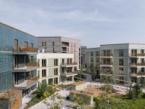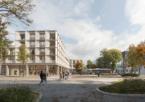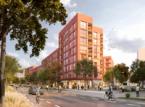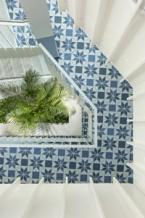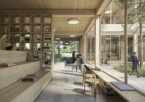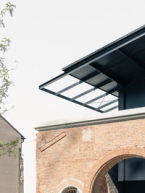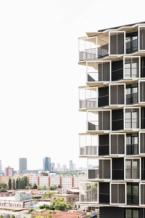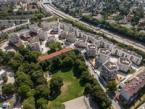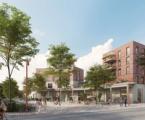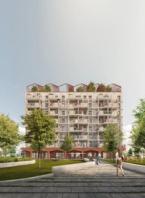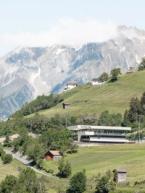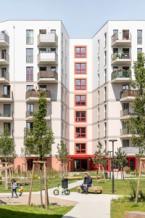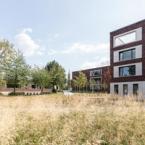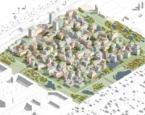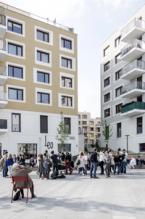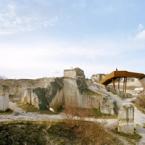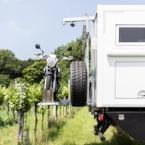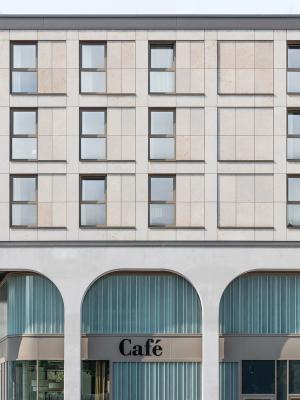The design of the new Technical Administration Building of the municipality of Düsseldorf rests on the foundation of a permeable plinth and articulates the large built volume required in the competition brief as a slender tower of four interlocked tall blocks.
New Technical Administration Building
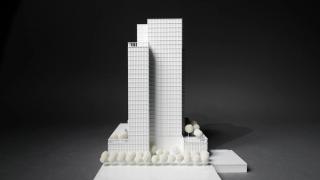
General planning: AllesWirdGut Architektur, Hertl.Architekten and FCP Fritsch, Chiari & Partner
Project stages: 1–8 (general planning)
Client: IPM Immobilien Projekt Management Düsseldorf GmbH
Competition: September 2022 – 1st prize
Projected completion: 2029
GFA: 106,500 m²
Team: Agron Deralla, Carolin Saile, Daniel Raske, Franziska Sturm, Karolína Mikitová, Lucia De la Dueña Sotelo, Markus Stürzenbacher, Michal Stehlík, Monika Prinčić, Ondřej Stehlík, Till Martin
Landscape architecture: DnD Landschaftsarchitektur ZT, Vienna
Structural engineering & building physics: FCP Fritsch, Chiari & Partner, Vienna
Technical building equipment planning: ZFG-Projekt, Baden
Fire protection planning: Corall Ingenieure GmbH, Meerbusch
Energy consulting: Transsolar Klima Engineering, Munich
Facade planning: knippershelbig, Stuttgart
Structural engineering (Competition phase): merz kley partner, Dornbirn
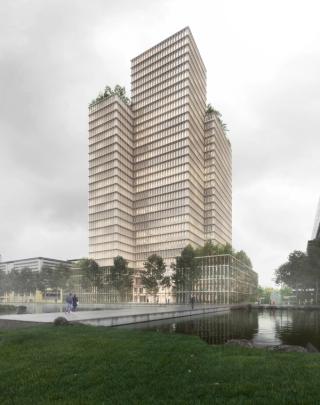
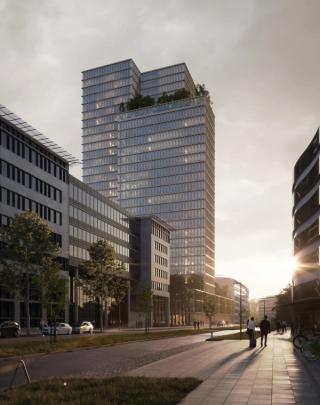
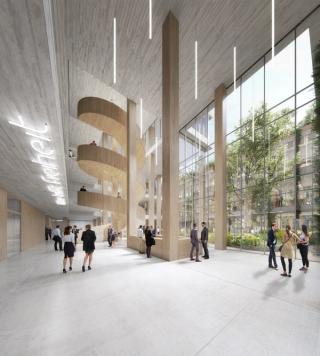

The green plinth is understood as a continuum of directional-space between Moskauer Strasse und IHZ Park whose open design establishes an intuitive connection between the two grade-line levels. A cleft in this building part—kept deliberately low in relation to the surrounding houses—marks the park-side main entrance. Intensive planting on the facades and the plinth-area rooftops invites passing through, and lingering in, the little urban oasis. Situated above the plinth is a conference center, the technical departments, and a traffic-guidance and tunnel-control center (with separate access). Offering catering and recreational facilities, the floors above that—accommodating a cafeteria with a large terrace and a work-life balance level—connect the public zones with the office floors. These are each structured into two flexibly usable office units revolving around three-story winter gardens and meeting rooms. The building’s climate and energy concept provides for utilizing local potentials from renewable sources through photovoltaic systems, rainwater harvesting, concrete-core activation,
geothermal energy as well as supplementary local heating and cooling. Also in line with the desired positive eco-balance of the building is the timber-concrete composite construction of all floors of the tower. With a high degree of prefabrication and short transport routes, the hybrid construction of the ceilings also makes for a resource-efficient solution. The individually developed zigzagged facade with photovoltaic and decentralized ventilation elements combines passive shading in summer with solar energy-production in winter. The greening concept for the Technical Administration Building provides for climate-resilient and wind-resistant tree species as intensely colorful grasses and densely growing climbing plants, interweaving the building with its surroundings, from the courtyard to the roof terrace. All through the ground-floor zone, open-air space unfolds from Moskauer Strasse to the park, opening into a generous public square with amenity areas, trick fountains, and loosely planted groups of trees.
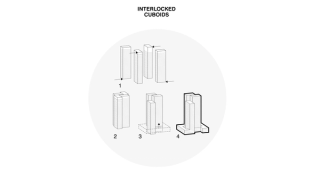
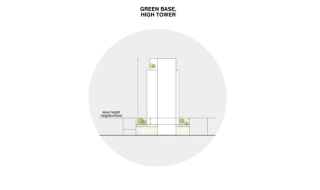
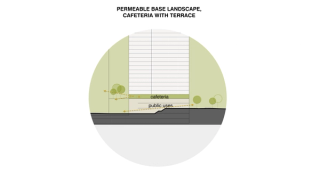
The new technical administration building in Düsseldorf sees itself as a house in and for the city. A tower made of four interlocking cuboids structures the building mass and creates a variety of visual relationships. It sits on a plinth with a large incision to the park marking the main entrance.
The base is deliberately lower than the surrounding buildings and thus gives the tower more “air”. The base zone mediates between the two levels on the building site and becomes a small oasis in the city thanks to the greening of the facade and the roof landscape.
Dr. Stephan Keller, Lord Mayor of the North Rhine-Westphalian state capital Düsseldorf
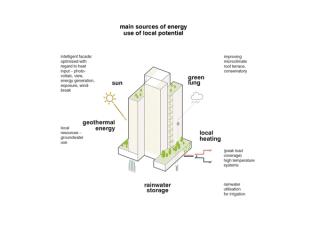
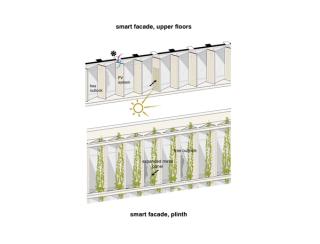
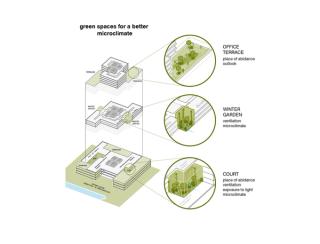
The use of local energy potential, including the use of regenerative cooling via local cooling, etc., not only makes sense in terms of energy, but also saves technical space at the same time.
Smart facade, upper floors: power generation on the facade / reduction of solar inputs in summer through photovoltaics / the outlying offices are ventilated via decentralized ventilation elements in the facade / the brim (overhanging horizontally) also improves the sun protection
Smart facade, plinth: facade greening / shading by expanded metal panels / the outlying offices are ventilated via decentralized ventilation elements in the facade
Spacious green spaces
Dr. Stephan Keller

Site plan
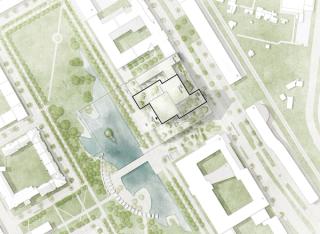
Site plan
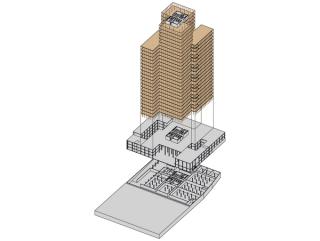
30% carbon dioxide savings through hybrid construction
Dr. Stephan Keller
Visualization: bloomimages, Illustrations: AllesWirdGut Architektur & Hertl.Architekten, Model: mattweiss
Hitachi Columbus Campus
Sustainable, simple, beautiful!

Doppelmayr Headquarters
Global Village
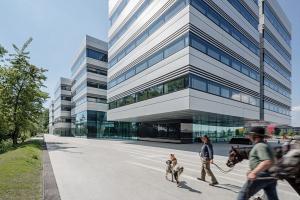
AllesWirdGut Architektur ZT GmbH
Untere Donaustraße 13–15
1020 Vienna, Austria
AllesWirdGut Architektur ZT GmbH
Jahnstraße 18
80469 Munich, Germany
AllesWirdGut Architektur ZT GmbH
Jahnstraße 18
80469 Munich, Germany
Associated Partners: DI Andreas Marth / DI Christian Waldner (CEO) / DI Friedrich Passler (CEO) / DI Herwig Spiegl
Member of the statutory professional association of architects and consulting engineers, Vienna,
Lower Austria and Burgenland: ZL 91.519/79-I/3/02
Member of the Bavarian chamber of architects
Commercial Court Vienna / Reg.No.: 228065s / Vat No.: ATU 55987702
Erste Bank Vienna / IBAN: AT67 2011 1280 2411 2400 / BIC: GIBAATWWXXX
